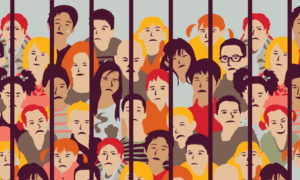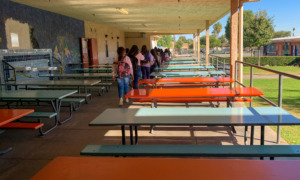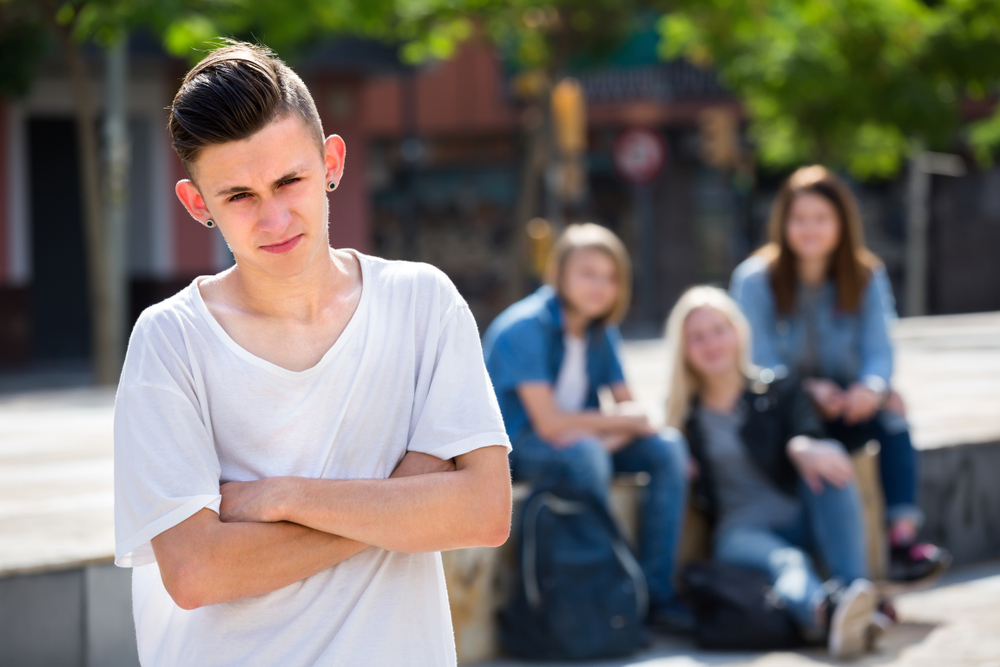
Iakov Filimonov/Shutterstock
.
What do you do when someone is obdurate and has no interest in taking responsibility or admitting any guilt at all?
This is a fairly common question and one that is quite broad. This concern highlights the frustration people can often experience when trying to impose a restorative justice system onto a school or institution instantaneously, without doing the necessary foundational legwork that supports the space and language of accountability.
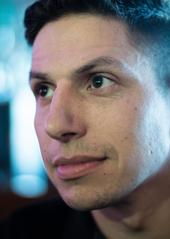
Nicholas Bradford
Expecting a person to take accountability in a restorative conference after a harm has been committed, without an ecosystem of restorative practices already in place, will often fail to produce the desired success such as authentic understanding, remorse, accountability, agency and repair.
We also operate with a “rush rush, rush” lifestyle and work environment. Slow down, ask more questions prior to having hard conversations. In our experience there are very few youth who are unwilling to take accountability. The vast majority are able and willing with a small amount of support, often from youth community members or support people. When youth are resistant to taking accountability, often they have something they need from adults first. This might be an recognition that they were also harmed, want an apology from an adult, need help with math or the football team or a personal relationship.
Remember, restorative practice is about practicing. We encourage you to think about a conference as an opportunity for youth to practice taking responsibility, practice using impact language and practice making amends. Much of this question can be answered with: What does this youth need to practice?
While we may often regard the youth we work with as not having empathy or not taking accountability, this is not unique to youth. Around the country we and the youth we work with see example after example of politicians, athletes, corporations and sometimes even us as parents not taking accountability. They see shifting blame, justification and excuses made for harmful actions and decisions all around them. They pick up on this lack of accountability and learn from it. Even in one of the most common events, the car accident, we are told not to say you’re sorry because it means you’re at fault.
Relationships are key
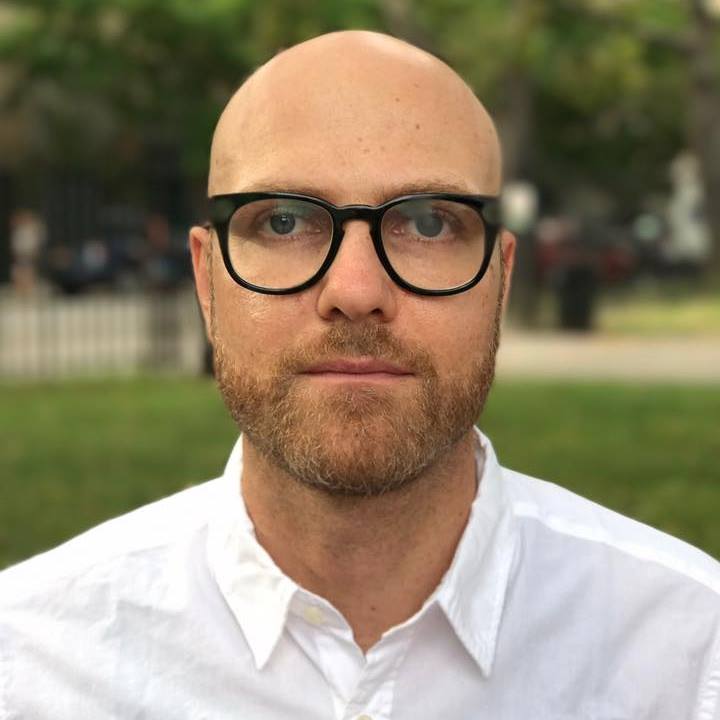
David Levine
Take care when looking for accountability. It is often a new and contrary message youth are hearing. As such, the work of building relationships and changing language is essential
There are many restorative practices that can help build a safe and accountable ecosystem, but at the National Center for Restorative Justice we see RJ as a relational approach to conflict and feel that relationship building has to be the cornerstone of the work.
Without strong relationships within the community, accountability seldom blossoms. It would seem that there has been a failure to build solid relationships in the instance, at least with this particular individual you are asking about. So, let’s talk about the world of relationships.
Let’s use an example. Say that Mark got into a physical altercation in the hallway outside Mr. Johnson’s room. Now you are sitting in a circle with Mark and others, explaining the disruptive impact of the fight, and Mark says, “I don’t care about Mr. Johnson,” or even worse “Who’s Mr. Johnson?” If Mark has not had a chance to get to know Mr. Johnson, to see him as a whole person who cares about Mark and that they both are valued members of the community, Mark will likely not care that he has harmed this person and may not even admit guilt or responsibility.
Imagine instead that this school or organization had in place regular discussion circles where someone like Mark might have shared thoughts across from Mr. Johnson, or if Mark had played a game of pick-up basketball with Mr. Johnson at a field day, or Mr. Johnson had participated in a talent show that Mark had seen. Or imagine the relationship had they both attended a camping retreat or battled a ropes course together. Further, if there was a robust curriculum of RJ practiced across the community, Mark might even be comfortable with the language being used to discuss his fight. Words like “harm, agency, accountability, act of apology, etc.” might be comfortable and easier to draw upon.
The next relationship we can look at is that between Mark and the facilitator of the circle where he is not taking accountability. If this is the only person trained to run such a circle, and Mark is unfamiliar with him/her, or does not like him/her, it may be very hard to get him to open up or take responsibility. Perhaps Mark has trouble trusting others or has poor attendance. Trying to find a facilitator who Mark has a positive relationship with or at least inviting such people to attend the conference, could go a long way. I’ve seen a highly reluctant student own up to their actions immediately after their respected football coach showed up to the circle. I’ve seen the same thing happen when a office secretary, who often greeted a student warmly in the morning when they signed in, was asked to have a one-on-one conversation before the circle to help them prepare.
Student needs good relationship with self
The final relationship we can look at is that of Mark to himself. It may surprise some people, but often the most defiant and outspoken and harmful people can often have very low self-esteem, or at least regard themselves as unwanted, hated or invisible in the community they have harmed. Does Mark have a general attitude of “I don’t care,” or “I’ve always been a bad kid,” or “Nobody wants me here anyway”?
During a conference there is a question I’ve used to assess this: “How would you feel if someone did this to you?” While this question is a bit heavy-handed, the answer can be eye-opening. “I wouldn’t care” is often a response and a big clue to this thinking. We often brush this type of response off as just kids not wanting to answer. While that can be true, it can also be a signal that Mark doesn’t have a positive self-perception. There is little chance he will feel remorse for disturbing Mr. Johnson’s class.
We would ask what opportunities Mark has had to not only connect with others, but with himself within this community. Have there been “Who am I?” projects that have allowed Mark to explore and celebrate his identity? Has Mark had a chance to exhibit his talents or skills, even if they don’t fit into the core curriculum? Has there been an effort to find even small areas where Mark can shine and receive authentic praise?
If Mark has come from a home where he was told he was “a worthless brat,” how valuable would it be for him to volunteer in the library and be told by the librarian, “Mark, I don’t know what I would do without your help organizing all these new books!”? Or maybe the class is asked to demonstrate something that they love and Mark gets a chance to show that he can break-dance, or knows how to make pasta for his family or is a talented rapper. Imagine if he had that chance to blow everyone away for even five minutes, and the sense of pride he would feel in that space. Now that would be a community where he started to feel of value and one that he would not feel good about harming.
What’s wrong with zero tolerance
For the skeptics or cynics: You might say why am I bending over backwards to get this kid to accept responsibility? He caused harm and I can hold him accountable by punishing him to the letter of the law. This is actually what occurs in schools and courtrooms across our country. We have a staggering amount of incarcerated people and student suspensions in the United States.
The problems here are many. First, both prisons and school suspensions have been shown to be highly ineffective at preventing recidivism. In fact, jail time and school suspensions have both been linked to a decrease in positive outcomes, not to mention the immense amount of time and resources we spend every year separating people from our communities.
One might think: “Mark will get suspended for three days for the fight and think about what he has done.” Most educators will laugh out loud at this sentence. More likely Mark will stay home alone and sleep, watch television or play video games, if not get into something worse.
In addition, many people who are punished sit at home or in juvenile detention seething about the injustice perpetrated against them. Recipients of punishment often feel like the victim, which makes it increasingly difficult to empathize with the victim. He will feel further ostracized from the school and have no one to guide him through those emotions. The response from his family may be one of concern and discussion, or it may be met with further punishment, or verbal and physical abuse.
Another problem with this “zero-tolerance” mentality is that punishments are disproportionately imposed on people of color versus their Caucasian counterparts. And, no, it is not a case of people of color causing more harm. It has been shown time and time again that people of color (and those with disabilities, Native Americans, LGBTQ people and other marginalized groups) are disproportionately punished for the same offence.
In addition, lower-income, urban schools are more likely to have “school resource” police officers roaming the halls, making a fight like Mark’s a chance for criminal arrest, where in higher-income or more rural settings the fight would be handled by staff and family alone, avoiding criminality. Because people of color live in these policed areas at higher rates, they are also at greater risk of their actions landing them in handcuffs.
We would also take a pause at the statement, “I can hold him accountable.” We believe it is impossible to hold someone else accountable. Authentic remorse and repair can only come from ownership by the “author” of the harmful act themself. We would love to see “He needs to be held accountable!” replaced with “How can we create a space for him to take accountability?” There is a world of difference when someone owns their actions as opposed to being punished by someone else for them.
Time for prevention vs. reaction
The final skeptic statement would be, “This all sounds great but I don’t have time for all this. I have to prepare my students for state exams.” While we agree that school staff are under a great amount of pressure to get through academic curriculum that does not include what we feel to be the crucial skills of social-emotional learning (another article there!), this is the reality. The restorative practice we are talking about does take time, training and commitment.
But what I would ask these skeptics is: How well is your current system working? How effective can Mr. Johnson be in preparing kids for the big algebra test when all his students are running to the window shouting as Mark gets into a fight? Not dealing with these issues of conflict properly will end up costing you more time. And if you simply push out (suspend) students who do have conflicts, you will quickly erode your graduation rates, because conflict is normal and it will keep occurring. You cannot completely prevent conflict. The only choice is how to respond to it and how to teach others to engage with it in a healthy and productive way.
Perhaps you are still scratching your head or thinking of a particular youth who struggles with accountability.
Has their side of the conflict been adequately heard? Mark may not be willing to take ownership for fighting if he has not gotten to explain things from his side. Perhaps the boy he fought has been saying some really nasty things about his sister or put gum into his hair. These are not excuses for fighting, but if those motivations are ignored, Mark may not feel willing to take ownership. For a system to be just, it also needs to be fair.
Is it possible to intervene much earlier than at the point of such a large event as a fight? Often there are protocols that must be followed for such an event with little flexibility. However, maybe if a restorative conference had occurred earlier, say when Mark had yelled out in class a few days earlier, we might have learned about the ongoing conflict he was having with the other student, or about his anger over things at home. This would have also been a great time to practice all the language of RJ, thinking about how he could have handled the situation differently, who he might have affected, etc. This might be easier for Mark to accept and you could practice a small “authentic act of apology.”
Maybe he simply writes an apology note to the teacher, explaining why he was angry, or helps the teacher clean up after a class, or paints a picture for the teacher to hang. In these ways Mark can see that his anger might have been justified, but yelling out was not appropriate, and he has the power (agency) to repair what happened and still be loved and accepted by the teacher/class/community. He never needs to be separated to learn this lesson; in fact, keeping him in the community is the only way to show he is supported in his growth. Once Mark feels that he is still “good” despite a poor choice, and that he is empowered to repair harm, it will be easier for him in the future, even in a larger event such as a fight, which will require a great deal more on his part to repair.
For some people, accepting responsibility is just plain hard, for many reasons. Often we have found success with “group author” circles. These are accountability circles comprised of a small group of individuals who have committed a similar offence. It might be for theft, or fighting, or even excessive tardiness. This helps people to see that their actions do happen in the community, that they are not alone or “bad,” and to learn from how others are processing their decisions.
Usually, once one person in the circle shares and owns their actions, there is a great deal of positive peer pressure and the other circle members begin to share. It is a great idea to have people of different ages in such circles. A senior student can share with a freshman how his tardiness means he will not graduate on time, or an older person can share with a teenager how spending seven years in prison affected his ability to get a job or see his daughter grow up. These stories can be extremely powerful when they come from a peer rather than an authority figure. The circle then feels like a support community in itself, rather than a disciplinary measure.
Curiosity + support
What is the result of owning your actions in this community? If Mark explains that he yelled in class because he is angry about things at home, does he get support or simply, “Well, that was still wrong and you are getting detention anyway.” Perhaps instead of detention, Mark might be invited to spend time after school with a counselor to help him deal with his home life. If he sees that owning his actions leads to a positive experience that benefits him he will be more likely to accept fault in the future. This does not mean that there has to be one or the other approach. Maybe in the case of the fight, a suspension is still handed out but it is also coupled with an RJ circle to address what happened, counseling or anger management, a creative act of apology and a reentry circle after suspension to check in with Mark’s mindset upon returning.
Changing the language from accusation to curiosity may be all it takes to create spaces of accountability. Rather than saying “Mark, I cannot believe you fought in the hallway,” you might try something like, “Mark, take a look at our five values on the wall. Which of those values were broken when you had that fight in the hallway?” By encouraging Mark to identify that safety was lost during the fight, he can separate himself from his actions and see how the community was affected.
Instead of telling Mark everyone who was harmed, you might ask him, “Who do you think was impacted by the fight?” A lot of young people will not see that anyone was impacted except themselves and the other person in the fight. Some general probing and discussion will help them see extended impacts such as to Mr. Johnson, his class of students, the staff who responded to the fight, the family who got called to the school, the janitor that cleaned up the mess, etc. This can be a valuable realization of the interconnectedness of the community he is a part of, but it needs to be realized through compassionate reflection, not a lecture from an authority figure.
Finally, there might be someone out there thinking, “My organization has these robust systems in place, my staff is trained and compassionate, we reflect on race/identity/privilege, we utilize these RPs [restorative practice] and still we have a student who resists taking accountability.”
To this we would say, look, this is not magic. It is about what is most likely to achieve the desired results: Mark understanding himself, his actions, their impact and how he can go about addressing and repairing the harm that was committed, and how to gain the skills to avoid causing harm in the future when he is in conflict. We are absolutely convinced that restorative justice is more effective than retributive justice in these regards, and that if you keep doing the work as a whole community you will begin to see wonderful results.
David Levine has worked as an educator at public high schools in Brooklyn and Seattle, and as a restorative justice dean in the Bronx. He is currently a course facilitator at the National Center for Restorative Justice, an organization that provides training for those looking to change their relationship to conflict. Contact him at d.levine@nationalcenterforrestorativejustice.com.
Nicholas Bradford is founder of the National Center for Restorative Justice. He is a lifelong educator with extensive work in conflict in schools, after-school programs and juvenile justice.




